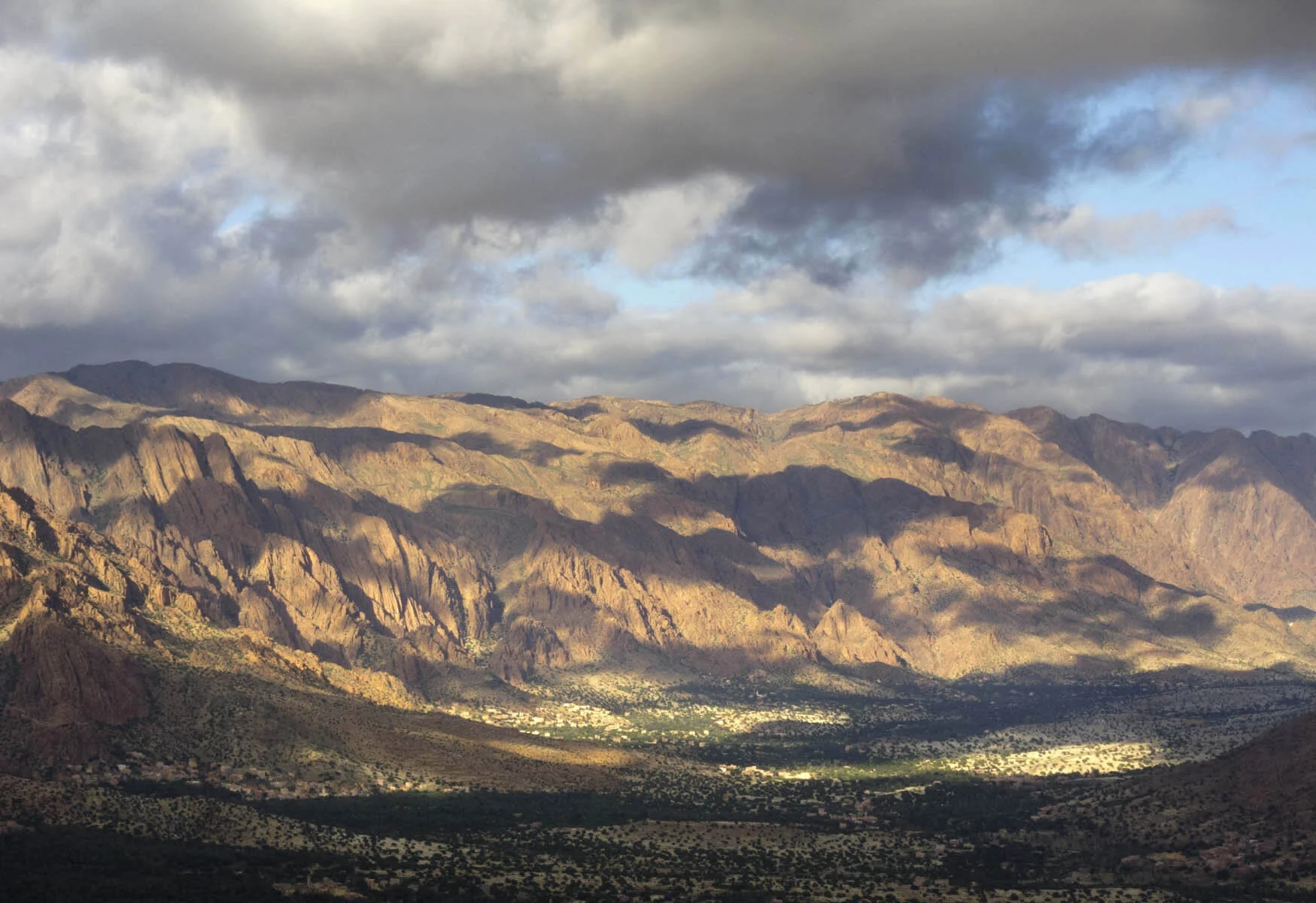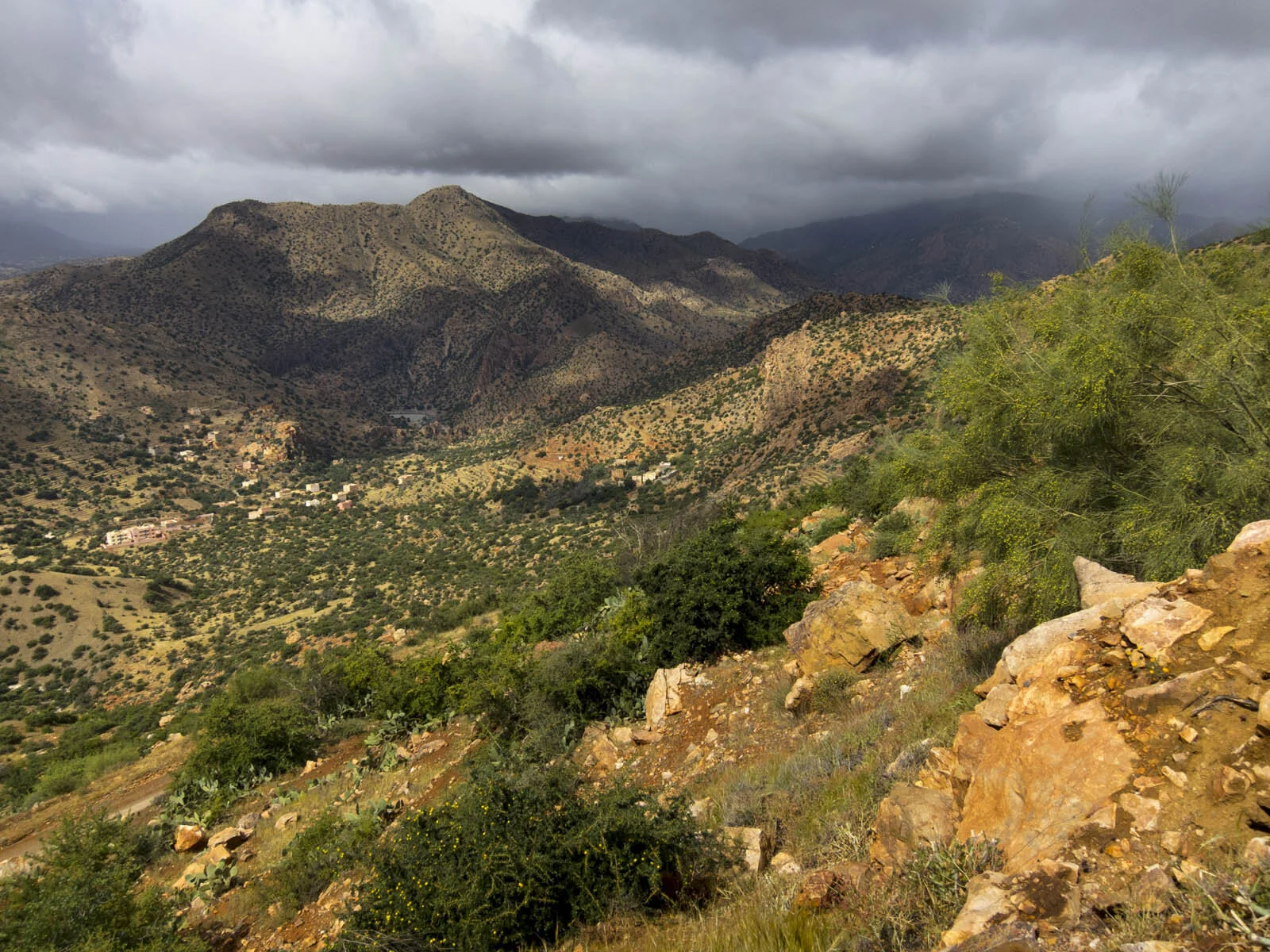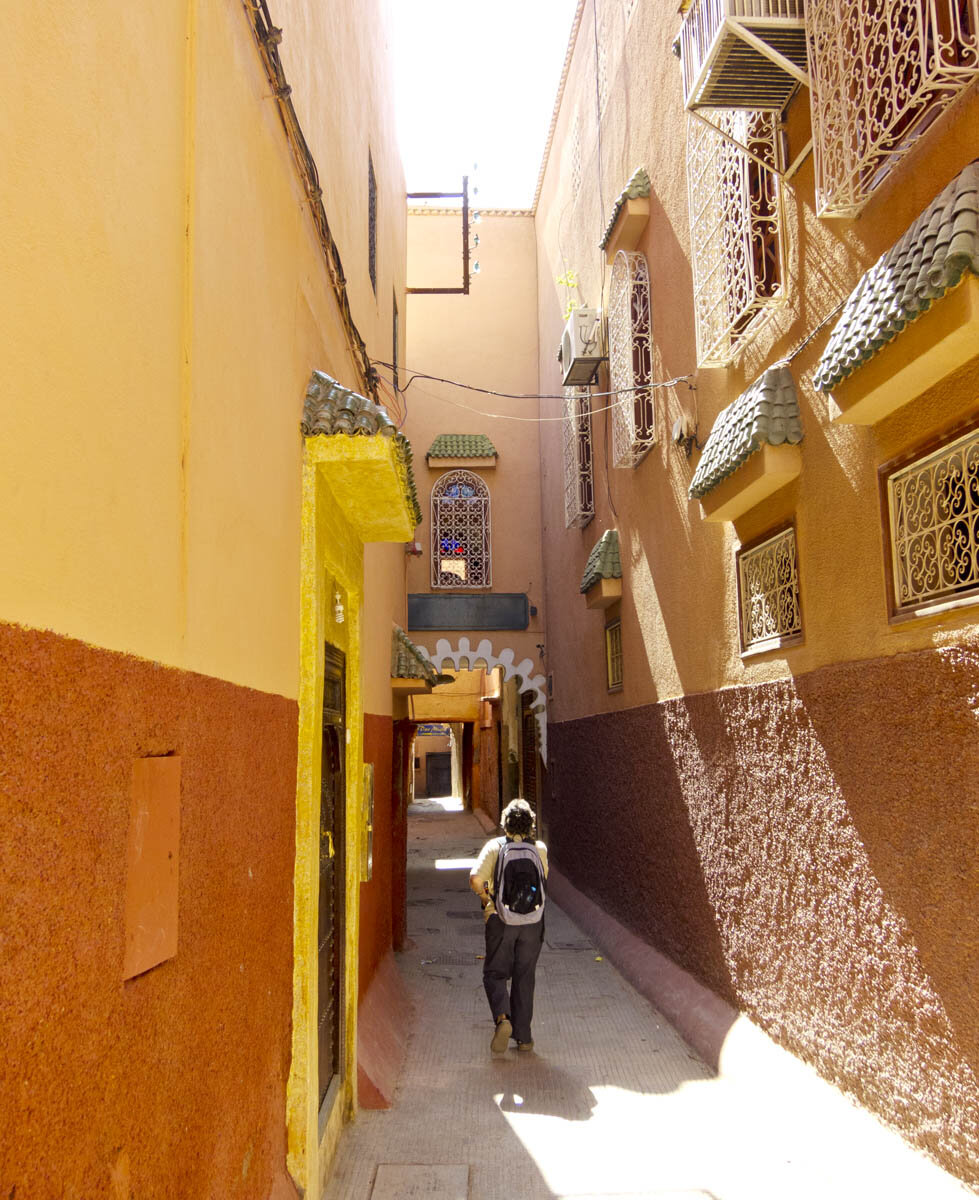Morocco trip, April 2011, part 2
After the abrupt weather change, showery conditions prevailed for the rest of our visit. Clouds wrapped themselves around the higher mountains. Dampness stopped us from attempting long routes, but now we could enjoy the shorter climbs. Also, now, without worrying about pesky early starts, we could relax and enjoy coffee and breakfast at the hotel in Tafraoute. Standard Moroccan breakfast is fresh-squeezed orange juice, great coffee, bread with various jams and, ah yes, foil-wrapped triangles of Laughing Cow. In a hot, poor country, the shelf-life of Laughing Cow, which is what?—probably several years, no fridge needed—make it a staple.
Of the lower-lying crags, Robins Hood Rocks comes highly recommended in the Steve Broadbent guidebook, Morocco Anti-Atlas North, so we headed there. There were great views on the way.
Jebel el Kest, clouds and sun
Yes! In the cool weather, the quartzite face climbs, protected by wires and small cams, came into their own. This was what we had come for!
Fran at Robin Hood Crag. The rock is better than it appears!
There’s no bolts on any of the quartzite climbs in the Tafraoute area, the climbing is strictly trad climbing; slabby to vertical, thought-provoking, puzzles of hard-to-see holds, hard-to-resist gravity and hard-to-place gear. Though, I began to wonder if the guidebook author must have used some kind of random-number generator when assigning stars and grades to climbs. Or had consulted with Eric Bjornstad, whose own southern Utah guidebooks were famously peppered with mistakes. A humble, two-star Severe, Sheriff’s Wall, labeled “bold” turned out to have oodles of gear and high-quality face climbing on heucos and ironstone flakes. Another two-star “bold” route, Down and Out, nearby, proved to be not only excellent and well-protected but surprisingly easy for the given E1 (~5.10a) feeling more like 5.8/5.9-.
Me, leading at Robin Hood Crag
The one-star E1 Call To Prayer (no pics, sorry) was the best of them all; a thought-provoking lead up a vertical maze of diamond-hard, shiny flakes. After each little flurry of moves, one reaches an impasse, a dead end at a half-decent hold; then, bit by bit, one surveys the terrain above and unravels the next sequence of moves and the upcoming protection possibilities. If this route were in Eldorado Canyon, or in Joshua Tree, it would be among the best, a popular classic. But here in Morocco, there was no chalk on the holds, no other climbers, little trace of anyone having climbed the route before us. Fabulous.
The view from Robin Hood: incoming weather over Tanalt
As Fran followed, the rain began in earnest. As we stumbled down the descent gully we eyed up a supposed 4-star route, Owl Crack—a zigzag offwidth with jagged edges and “occasional rodents.” Four stars? Yikes.
Since the one-star climbs were our favorites, and the crag held plenty more one-star routes we had not done, we resolved to return next day. But alas, next day we woke to heavy rain, so we decided to explore the ancient walled citadel of Tizourgane.
Tizourgane. Hilltop citadel dating back the thirteenth century
I’ve always enjoyed exploring old stone ruins, silent testimony to human aspirations. Or is it human fears? Either way, the massive effort, ambitious engineering and subsequent dereliction makes me wonder what will survive of our modern cities and towns, hundreds of years from now. And what will future archeologists make of the surviving structures. Tizourgane, it turned out, was fascinating. Part ruin, part modern-day dwelling, it has been continually occupied since the thirteenth century. In the last few decades most people have left, a part of a relentless ongoing migration away from the country and to the big cities.
Tizourgane walls and poppies
The intricate stonework and elaborate, semi-random system of passageways and rooms reminded me of the masonry of Chaco Canyon. At the apex of the entire structure we found a cafe, where we drank tea and talked to the owners, who hoped to rehabilitate the citadel and attract tourists.
The woman who served us tea explained that her husband was from the last family to live there. Tizourgane, she explained, was not so much a military-style castle as a secure, shared place for locals to store and protect valuable items, contracts, jewelry, food stores.
Recently Tizourgane has been somewhat restored to its former glory, and hopefully might draw a few tourists to the area. Unemployment is high, and money scarce. In many of the local villages, many of the young adults are gone, earning money in the big cities and sending back occasional checks to the remaining families.
Later that day, the rain eased off and we went for a hike amid spectacular scenery:
Big views near Adrar Idikel
Big skies and wide vistas near Adrar Idikel
Next day, we headed for the coast, and the town of Mirleft:
Atlantic Ocean waves and the beach of Mirleft
Our accommodation, a comfortable guest house run by a friendly woman on the clifftop above the sea, filled with the noise of surf pounding into the beach below. Eager to explore, we scampered down stone steps, leaned into the wind and walked the sand just out of reach of majestic Atlantic breakers.
Next day the wind died down and we visited a different sector, Legzira beach. This was just about the best beach I've ever seen in my life. There were acres of that perfect sand that, had I been the right age, could have occupied me all day, sculpting dreamy sandcastles and digging deep, mysterious holes. Us adults had to retain some dignity, so we hiked along the beach to check out several magnificent arches:
And, later, a ruined castle atop a hill just outside of town:
Mirleft Castle
All too soon, it was time to head back to Marrakech. We had time for one last wander through through the souks…
and the colorful alleys…
And Ben Youssef Madrasa, once a college, now a museum.
Intricate tilework at Ben Youssef Madrasa museum
All seemed normal at the big Marrakech square, the bustle and noise, friendly throngs of people.
It was only when we were waiting in line at Marrakech airport, waiting to check in for our flight back to London, that fellow passengers told us that earlier that day a bomb had gone off in a bar overlooking that same big Marrakesh square, killing over a dozen people. We had wandered by just a couple of hours after the explosion, noticing nothing.
The bar that was blown up was the Argana. It’s on the right in the picture above (this picture was taken a week earlier). The bombers were seeking maximum carnage and publicity but they picked the day before the British Royal Wedding between William and Kate, so newspapers pushed reports of the attack deep inside their pages.
Morocco is not an easy, convenient place to visit, nor is it really very cheap to stay. The two climbing guidebooks for where we went have their shortcomings. But we felt safe everywhere we went, we were welcomed with smiles and treated with kindness by all. Morocco needs tourism, it needs income. Every minute we spent in Morocco was an adventure; and what does a climber crave if not adventure?

















